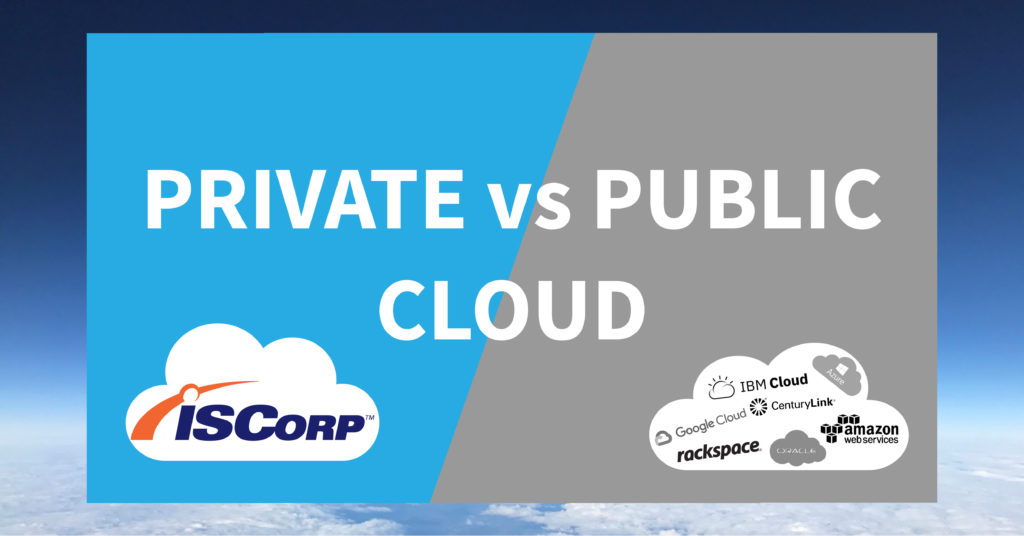
From the desk of an ISCorp Senior Infrastructure Architect…
WHAT IS THE CLOUD?
As a business professional in a technology-related field, buzzwords are commonplace. One of the greatest is “The Cloud”. What exactly is “The Cloud”? Originally, computers were often centralized, in either a single datacenter or as a single set of components often called a ‘mainframe’. As computing power increased and sizes shrunk, computers moved from massive data centers, and onto desktops. Technology leaped again, and connectivity of those systems ushered in the era of ‘Networks’. Further advances in telecommunications moved us into a ‘network of networks’ architecture, otherwise known as the ‘Internet’. Datacenters became collections of smaller systems, and not just a few, often being comprised of hundreds if not thousands. Linking these vast computing resources together over the “Internet” became commonplace, and as such, “The Cloud” was formed: An interconnected set of computing resources, joined through advanced network connectivity to facilitate information, business, and other related activities. By running your application on the ‘Cloud’ you run your application in a remotely connected set of systems either hosted at a public data center or a private institution.
When seeking a “Cloud” provider you have the choice of either utilizing a “Public” provider of computing resources, or a “Private” host. There is a significant difference between the two.
Public Providers:
“Public” cloud providers are accessible computing resources and storage that is made available to whoever can pay. Heavily virtualized and shared resources are made available at low prices, to entice you onto their platform. They often also provide a number of ‘build your own’ type services, which can offer a lot of features to an organization, which might not have the localized resources to build or manage. In addition, they partner with other software vendors, whom they also run on their platform or have a business partnership (often with revenue sharing agreements).
While these providers can often be found for low initial prices, they are known for certain revenue mechanisms… Oftentimes these systems are heavily monetized, as managing a data center and resources is a complex and expensive affair. Systemic resources are ‘monetized’ by charging based on a number of machines, by CPU and by Memory allocation, and through metered resources (such as network bandwidth, IP address, Disk usage, etc.) They are also heavily virtualized, at so many layers, it can be difficult to determine if the computing capacity is actually available for use, or if it’s just a ‘target’ that might be possible if you happen upon a system that is currently unused.
Public providers heavily utilize ‘standardized’ components, which don’t allow for much customization, as a means of keeping growth high to facilitate as many customers as possible and achieve any revenue targets. They also use tactics, such as charging for bandwidth “out” of the data center, or proprietary technologies, as mechanisms to help keep you locked into their ecosystem and make it more difficult for you to leave (the fabled “Hotel California” technique). They also tend to be known for their ‘surprise’ billings, due to metered resources that change constantly or change pricing depending on the ‘tier’ you might have achieved through utilization. They do their absolute best to make it easy for you to get onto their platform and do everything in their power to prevent you from leaving.
Private Providers:
“Private” cloud providers are similar in that they provide resources to customers but are often much more customized. They are often geared towards particular business verticals, offering specialized resources to certain industries which might have less commonplace needs (i.e. Financial, Government, Education, Scientific, etc.). In addition, they can be sometimes hard to find. In many cases, they host various services or vendor applications for both private and publicly facing institutions, giving those customers the spotlight whilst quietly existing in the background facilitating their customer requirements.
Most private providers also offer a number of various flexible services and facilities. Since their goal is structured more around making their customers successful (rather than growing as a function of their own means), they tend to be flexible with both different types of services offerings, how those offerings are managed and importantly: Billed. While private providers can often cost more than public organizations, what you trade-in cost is flexibility, specialized industry services, and customization to just your specific business needs. Certain cloud providers like ISCorp have flexible billing mechanisms and contracts so that rather than charging for an ever-changing set of resources or utilization, a more measured and structured approach can be taken. This allows your business to concentrate more on how to grow your customers, instead of having to figure out what your next billing cycle might look like.
Not to mention, most private vendors offer ‘privatized’ resources. These are resources that are dedicated to your business alone, instead of being shared by other customers. This can be a significant advantage for those customers that have contractual, legal, or compliance requirements which can often be difficult to facilitate on a ‘shared’ set of resources or architectures. And that’s just the beginning. Want a mixture of co-located and managed services? Private providers like ISCorp can customize the resources around your needs and have partnered with such industry vendors such as the Arnett group to deliver data center relocations services to make the process as painless as possible. Want managed services surrounding not only your systems but your applications and customer service? ISCorp has you covered. With a 24×7 helpdesk team, network operations group, and on-staff application, system, security, and database administration staff – we have personnel who will help you find the best possible means to get your business to where you need to go.





